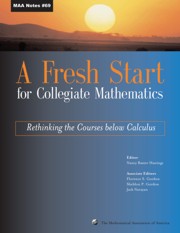Book contents
- Frontmatter
- Preface
- Contents
- Introduction
- Background
- 3 Who are the Students Who Take Precalculus?
- 4 Enrollment Flow to and from Courses Below Calculus
- 5 What Have We Learned from Calculus Reform? The Road to Conceptual Understanding
- 6 Calculus and Introductory College Mathematics: Current Trends and Future Directions
- Theme 1 New Visions for Introductory Collegiate Mathematics
- Theme 2 The Transition from High School to College
- Theme 3 The Needs of Other Disciplines
- Theme 4 Student Learning and Research
- Theme 5 Implementation
- Theme 6 Influencing the Mathematics Community
- Ideas and Projects that Work: Part 1
- Ideas and Projects that Work: Part 2
4 - Enrollment Flow to and from Courses Below Calculus
from Background
- Frontmatter
- Preface
- Contents
- Introduction
- Background
- 3 Who are the Students Who Take Precalculus?
- 4 Enrollment Flow to and from Courses Below Calculus
- 5 What Have We Learned from Calculus Reform? The Road to Conceptual Understanding
- 6 Calculus and Introductory College Mathematics: Current Trends and Future Directions
- Theme 1 New Visions for Introductory Collegiate Mathematics
- Theme 2 The Transition from High School to College
- Theme 3 The Needs of Other Disciplines
- Theme 4 Student Learning and Research
- Theme 5 Implementation
- Theme 6 Influencing the Mathematics Community
- Ideas and Projects that Work: Part 1
- Ideas and Projects that Work: Part 2
Summary
The intent of the analysis
In rethinking the courses below calculus, two questions naturally arise:
What mathematics courses (calculus and otherwise) will students take after completing courses supposedly intending to prepare them for calculus?
What mathematics courses have students studied before calculus and calculus preparation courses, and how recent is their knowledge?
This report attempts to partially answer these two questions based on a study that tracked the actual enrollment of students in precalculus, calculus, and non-calculus based courses over 20 successive semesters, from fall 1992 to spring 2002. This is a study of the enrollment flow of students on a microscopic level, in that it tracks the enrollment of individual students at the University of Nebraska-Lincoln, a large midwestern university. This study allows us to examine actual student behavior along with changes and trends in that behavior over time. This is in contrast to national studies tracking the yearly number of students enrolled in generically labeled groups of courses (e.g., precalculus which encompasses college algebra, college algebra and trigonometry, precalculus, etc.) which gives a macroscopic view of trends in enrollment. This is also an examination of the probable success of calculus preparation curricula which plan student movement from course to successive course in sequential semesters in that the study examines actual student behavior, which may vary from the ideal. The data source Each semester the registrar generates a “correction roster” for the Department of Mathematics and Statistics.
- Type
- Chapter
- Information
- A Fresh Start for Collegiate MathematicsRethinking the Courses below Calculus, pp. 28 - 42Publisher: Mathematical Association of AmericaPrint publication year: 2006
- 3
- Cited by

